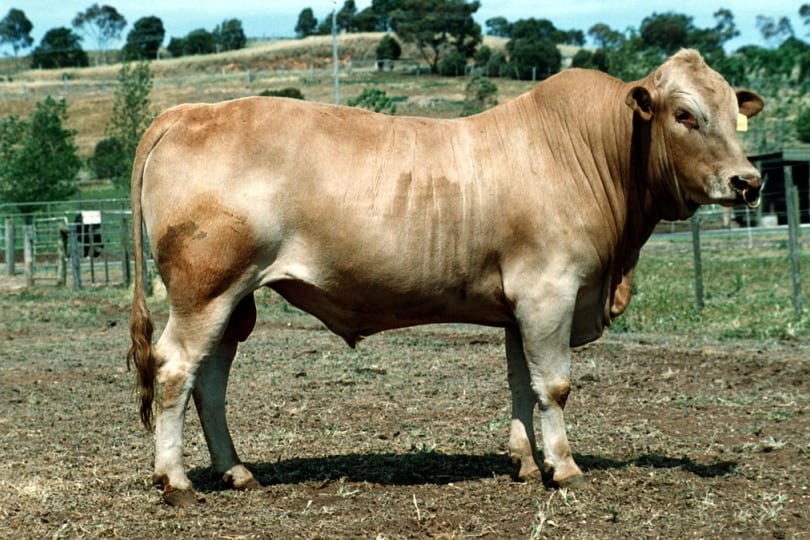Tuli cattle originate from Zimbabwe. They are closely related to cattle from surrounding areas, namely the Tswana breed from Botswana. They are typically a single color, which ranges from yellow to brown to red. They have a small cervical hump that sets them apart from many other cattle and makes them easier to identify.
While this breed is not terribly popular today, they have been imported throughout much of the world. They are now seen in the United States, Argentina, and Mexico. Australia imported the cow some years ago through the use of an embryo transfer, which helped prevent possible transfers of African cattle diseases.

Quick Facts about the Tuli Cattle Breed
| Breed Name: | Tuli Cattle |
| Place of Origin: | Zimbabwe |
| Uses: | Meat |
| Bull (Male) Size: | 750 kg(1,600 pounds) |
| Cow (Female) Size: | 400 kg(900 pounds) |
| Color: | Uni-colored |
| Lifespan: | Unknown |
| Climate Tolerance: | Arid |
| Care Level: | Low |
| Production: | Meat |

Tuli Cattle Origin
The Tuli breed was originally founded by the Rhodesian Government in an attempt to breed a native breed that could survive in the hot, dry conditions. The experiment took part at a government-owned plant and was overseen by Len Harvey, who was a member of the Department of Agriculture. The process began in 1949 and continued until the breed was well established.
To create the bred, Len Harvey attended most of the local cattle sales and selected animals for the foundation stock. Many cows of Tswana origin were utilized, as they were already suited to the environment. Furthermore, they were also quite productive and fertile. The Tuli breed was bred to maintain many of these characteristics.
Many of these cattle were distributed to local farmers after they were bred. However, they were soon exported to other countries that were interested in these cattle.
Tuli Characteristics
These cows are extremely practical. They mature quickly and without extensive care. They are quite docile, which makes them easier to work with. They are also extremely good mothers and very fertile, so herds can increase quite rapidly. Many farmers love this breed because they calve extremely easily.
Perhaps most importantly, these cows can withstand all levels of heat and dry conditions without showing any signs of stress or diminishment of their health. They have great vigor and do not mind the heat.
Furthermore, these cows are also known to be very disease-resistant. Therefore, they are often bred with other breeds that are prone to certain diseases.
Uses
For the most part, these are meat cows. Of course, they may also be used for a variety of other purposes on a purely practical level. Sometimes, they may be utilized for milk, for instance. However, they were originally bred as meat producers.
They can be slaughtered at only 18 months of age thanks to their quick maturity. Their meat has received excellent ratings for its flavor and marbling.
Appearance & Varieties
Tuli cows come in three solid colors: red, yellow, and white. All of these colors allow them to adapt to intense sunlight and do better in arid conditions. They also have a small hump on the back of their neck, which makes them stand out from other common cattle breeds.
Beyond that, these cows have a very practical appearance. They do not look extremely big and bulky like some other breeds, as this would make them vulnerable to the heat.
Habitat
These cows are designed to handle arid environments—it’s what they’re made for. Therefore, they are absolutely a breed made for the heat. They do great in desert regions and hotter environments. However, they are not suitable for colder areas at all.
For the most part, these cattle are utilized in places where it is simply too hot and dry for other breeds.

Are Tuli Cattle Good for Small-Scale Farming?
As always, it depends on your climate. If you’re in a hot (bordering on hostile) environment with very little feed resources, this cattle breed is probably one of the few that will thrive. However, they really do best in arid environments, so we don’t recommend using them elsewhere.
The cows also produce a lot of meat per pound of feed. In fact, they produce more than many other breeds, making them much more efficient. For this reason, they are a great option for land that just doesn’t yield a lot.
See Also:
Featured Image Credit: Tuli Bull grazing in the field (Image Credit: CSIRO, via Wikimedia Commons, CC BY 3.0)
